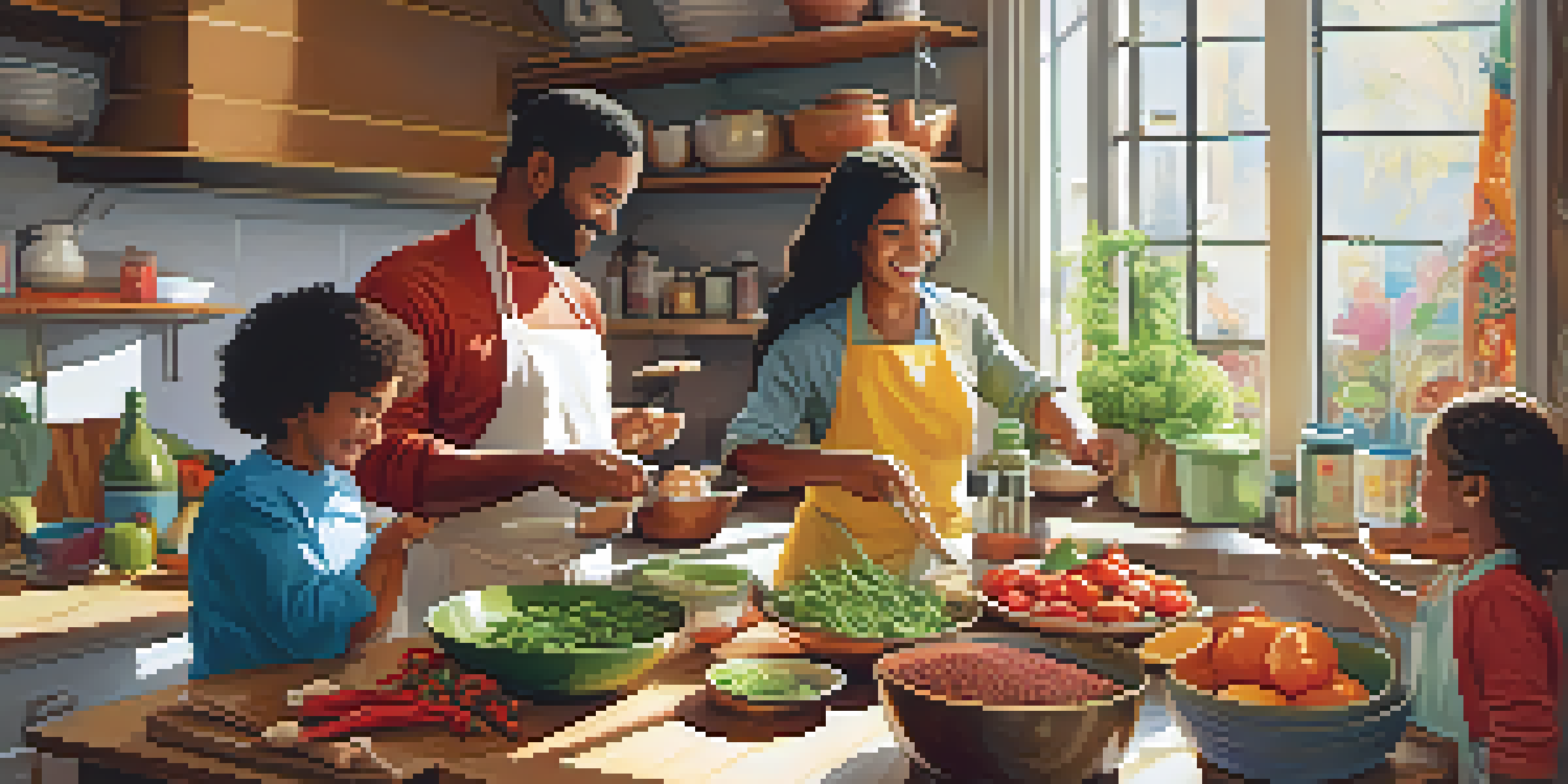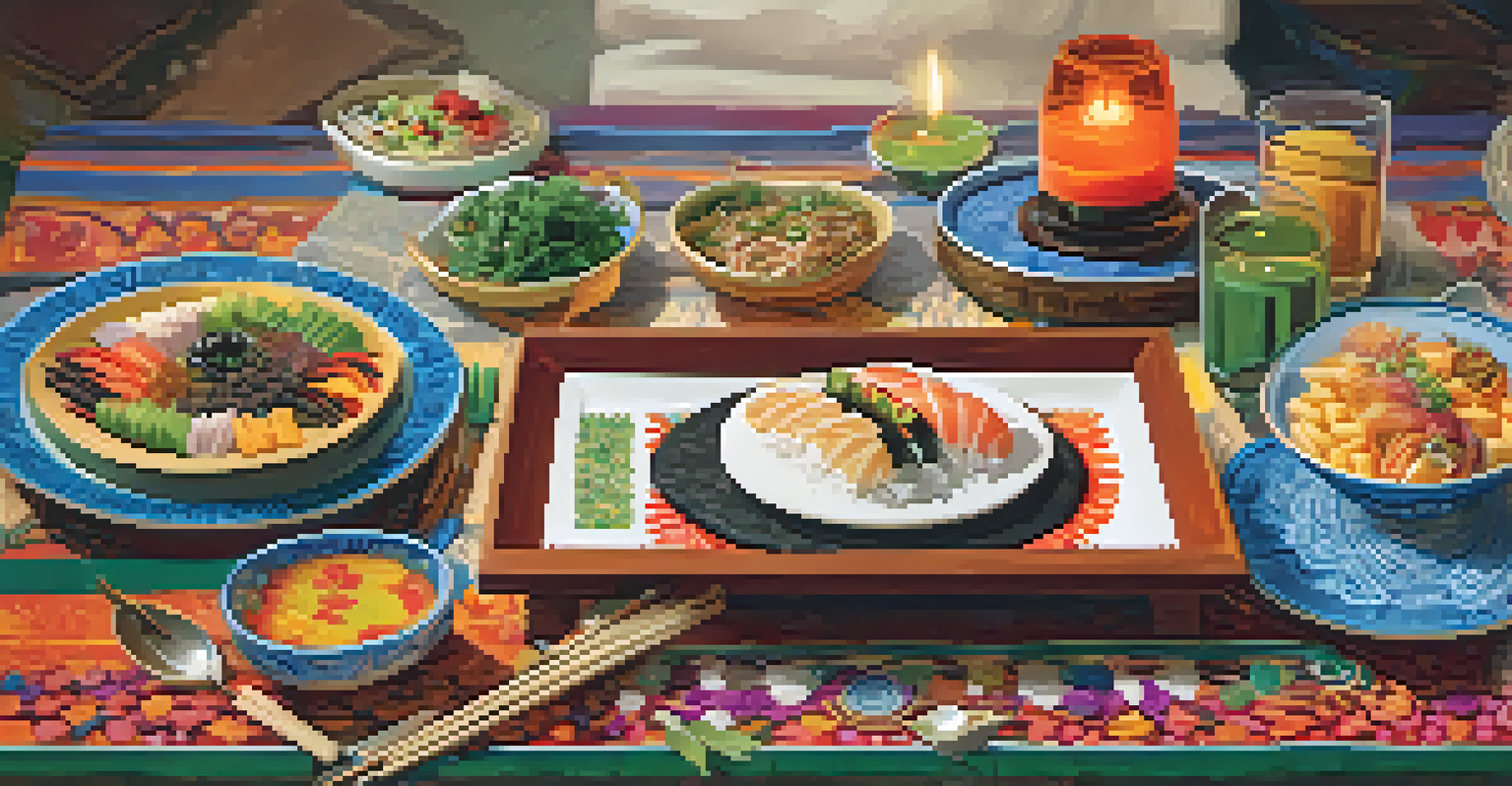Incorporating Cultural Foods into Kids' Diets

Understanding the Importance of Cultural Foods
Cultural foods are not just meals; they're stories and traditions passed down through generations. Incorporating these foods into your child's diet can expose them to different flavors and histories, enriching their culinary experiences. This exposure can also foster an appreciation for diversity and multiculturalism from a young age.
Food is our common ground, a universal experience.
When children try foods from various cultures, they often develop a broader palate. Instead of sticking to the same old mac and cheese, they might become curious about Indian curry or sushi from Japan. This curiosity can lead to healthier eating habits as they explore nutrient-rich options from around the world.
Moreover, food is a fantastic way to bond with family. Cooking traditional recipes together can create lasting memories and traditions. These shared experiences can make kids more interested in trying new foods and understanding their cultural significance.
Easy Ways to Introduce Cultural Foods at Home
Start by incorporating one new cultural dish a week. For instance, you might try Taco Tuesday with a twist by using authentic Mexican recipes. This gradual approach allows children to acclimate to new flavors without feeling overwhelmed.

Another idea is to involve your kids in the cooking process. Letting them help prepare a dish from a different culture can spark their interest. They can learn about the ingredients and cooking techniques, making the meal more exciting and engaging.
Cultural Foods Enrich Experiences
Incorporating cultural foods into your child's diet fosters an appreciation for diversity and broadens their palate.
Don’t forget to tell stories related to the food! Share why a specific dish is beloved in its culture or any personal experiences you have with it. This storytelling can create a deeper connection to the meal and encourage kids to be more open to trying new foods.
Utilizing Global Ingredients for Familiar Dishes
You don’t have to completely overhaul your meal plan to include cultural foods. Instead, think about how you can infuse global ingredients into familiar dishes. For example, adding some Asian spices to a stir-fry can make an ordinary dinner feel extraordinary.
Cooking is like love; it should be entered into with abandon or not at all.
Consider swapping out traditional pasta for whole grain or lentil versions, which are popular in many cultures. This small change can lead to significantly healthier meals while introducing your kids to new textures and flavors. It’s a simple yet effective way to diversify their diet.
Experimenting with sauces and marinades can also make a big difference. A flavorful chimichurri sauce on grilled chicken can transport your taste buds to Argentina. By adding just one cultural element to a meal, you can make it exciting without changing everything your family loves.
Exploring Cultural Food Festivals and Events
Attending local food festivals or cultural events can be a fun way to expose your kids to different cuisines. These festivals often feature cooking demonstrations, tastings, and activities that educate children about various cultures. Plus, it’s a great family outing!
When kids taste different foods at these events, they may become more adventurous about trying new things at home. Encourage them to describe what they liked and explore recipes inspired by their favorites. This can strengthen their interest in cultural foods.
Engaging Kids in Cooking
Involving children in preparing cultural dishes sparks their interest and creates lasting connections to the food.
Additionally, these experiences can ignite curiosity about travel and learning. Kids might express a desire to visit the countries where their favorite dishes originate, creating a desire for exploration and understanding of the world.
Making Cultural Foods Fun and Engaging
Presentation matters, especially for kids! Turn meals into a fun experience by creating themed dinners. For instance, you could have an Italian night with spaghetti, but also include a game of bocce ball afterward to get everyone involved and excited.
Consider involving your children in choosing the cultural foods to try. You can create a family calendar with different cuisines for each week. This element of choice can make them feel more invested in the meals and encourage them to explore new tastes.
Fun food-related activities, like making homemade sushi or decorating cupcakes with inspiration from different cultures, can further enhance the experience. These activities can turn mealtime into an adventure, making it more likely that kids will embrace new foods.
Addressing Picky Eaters and Cultural Foods
If your child is a picky eater, introducing cultural foods might seem challenging. Remember, it’s about patience and creativity. Start with milder flavors or familiar textures, and gradually introduce more complex dishes as their palate expands.
Encourage kids to take small bites of new foods without pressure. Make it a game to guess the flavors or ingredients. This approach can turn tasting new foods into a fun challenge rather than a stressful experience.
Celebrating Heritage Through Meals
Sharing family recipes and traditions helps children connect with their cultural roots and promotes pride in their identity.
You might also want to have a fallback plan. If they don’t like a new dish, offer a familiar side that they enjoy. This way, they won’t feel overwhelmed, and they’ll still have something on their plate that they’re comfortable with.
Celebrating Cultural Heritage Through Food
Food is a great way to celebrate your family's cultural heritage. Take the time to share recipes that have been passed down through generations. This not only helps children connect with their roots but also instills a sense of pride in their identity.
Involving children in family traditions, especially during cultural holidays, can deepen their understanding of their background. Cooking special meals and sharing stories about their significance can create lasting memories and teach kids about the importance of heritage.

Encouraging kids to share these foods with friends can also promote cultural exchange. When they invite friends over to enjoy traditional dishes, they become ambassadors of their culture, fostering understanding and appreciation among their peers.